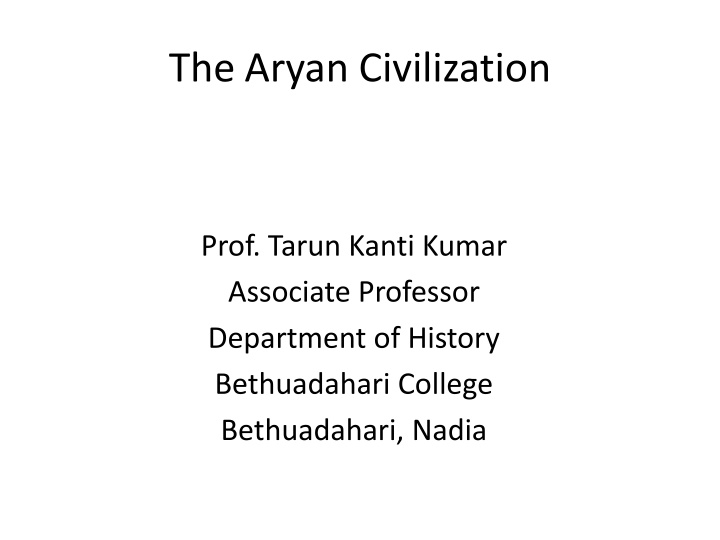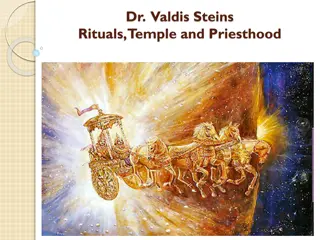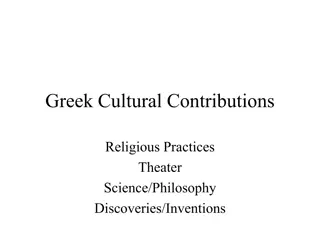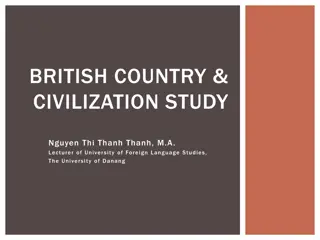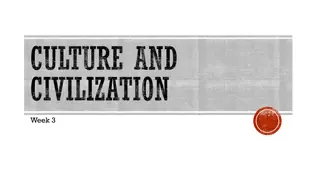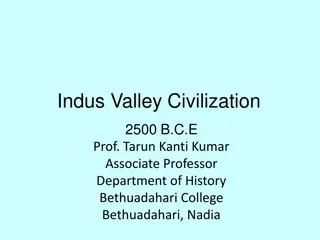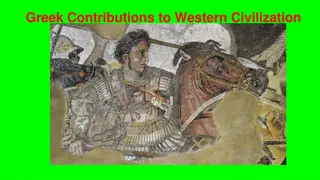Aryan Civilization: Migrations and Influence on Harappan Society
Aryan civilization, consisting of nomadic and pastoral Aryans who migrated to northern India around 1500 B.C.E., had significant impacts on Harappan society. The Aryans established small communities, clashed with Dravidians, survived on a pastoral economy, and contributed to the development of Vedic religion during the Vedic Age. This era marked a period of interactions, conflicts, and cultural exchanges between different groups in ancient India.
Download Presentation

Please find below an Image/Link to download the presentation.
The content on the website is provided AS IS for your information and personal use only. It may not be sold, licensed, or shared on other websites without obtaining consent from the author.If you encounter any issues during the download, it is possible that the publisher has removed the file from their server.
You are allowed to download the files provided on this website for personal or commercial use, subject to the condition that they are used lawfully. All files are the property of their respective owners.
The content on the website is provided AS IS for your information and personal use only. It may not be sold, licensed, or shared on other websites without obtaining consent from the author.
E N D
Presentation Transcript
The Aryan Civilization Prof. Tarun Kanti Kumar Associate Professor Department of History Bethuadahari College Bethuadahari, Nadia
Enter: The Aryans Approximately 1500 B.C.E. a nomadic and pastoral people who spoke the Indo-European language passed through the Hindu Kush mountains. They called themselves Aryans or noble people. They established small herding and agricultural communities throughout northern India. Their migrations took place over several centuries.
Aryan Influence onHarappan Society Aryan migrations took place over several centuries. Their arrival was not an invasion or organized military campaign. It is likely that Indo-European migrants clashed with Dravidians (people settled in the Harappan area.) By the time Aryans entered India, internal problems had already brought Harappan society to the point of collapse.
Aryan Influence onHarappan Society The Aryans survived on pastoral economy, sheep and goats. The especially prized their horses and cattle, but horses did not breed well in India so they had to import animals from Asia. The Aryans consumed both dairy products and beef. Centuries later cattle would become sacred.
Aryan Influence onHarappan Religion The Vedas were collections of religious and literary poems and songs transmitted orally. There were four parts. The most important part was the Rig Veda, a collection of 1,028 hymns addressed to the Aryan gods. Aryan priests compiled the Rig Veda between 1400 and 900 B.C.E. It wasn t put into writing until about 600 B.C.E.
The Vedic Age 1500 to500B.C.E. The Vedas refer often to conflicts between Aryans and the Dravidians and other people already living in India. The Vedas refer to Indra, the Aryan war god and military hero, who would destroy parts of the city. This suggests that the Aryans clashed repeatedly with the Dravidians of the Indus valley, attacking their cities and wrecking their irrigation systems.
The Vedic Age 1500 to500B.C.E. The Aryans often had friendly relations with Dravidian peoples. They learned about the land and adopted Dravidian agricultural methods. Still there was competitions over land and resources. It appears that the Aryans did not have a formal government but they formed chiefdoms with a leader known as a raja (Sanskrit term for king.)
Aryan Migrations in India Aryans first settled in the Punjab, the upper Indus River valley that straddles modern-day border between northern India and Pakistan. They spread east and south and established communities throughout much of the subcontinent. They learned to make iron tools and with axes and plow they cleared forests and established agricultural communities in the Ganges valley. The Aryans gradually lost the tribal political organization they had brought into India and evolved into small kingdoms with formal governments.
The Caste System Originally based on color: Aryans were wheat-colored and Dravidians were darker skinned. Four Main Varnas or Castes: Priests (brahmins) Warriors and Aristocrats (Kshatriyas) Cultivators, artisans, and merchants (vsaishyas) Landless peasants and serfs ( shudras) Untouchables (people who performed dirty tasks) added much later
Jati (Subcastes) As Vedic Society became more complex and specialized, the caste system changed to include specialized occupations. Occupation determined an individuals jati (subcaste). By the 18th and 19th centuries C.E., the system featured several thousand jati. Brahmins alone have some 1,800 jati.
The Development of aPatriarch Society Aryan Society had a strong patriarchal social order at the time of their migration into India. All priests, warriors and tribal chiefs were men. Women influenced affairs within their families but had no public authority. Women rarely learned the Vedas and were denied formal education. Sati, the practice of a wife sacrificing herself on her husband s funeral pyre, was considered noble.
Religion in Vedic Age The Rig Veda sheds light on religious practices. The chief deity was Indra, a war god, who was partial to fighting and drink. Varuna was a god who presided over the sky from his heavenly palace. He oversaw behavior of morals and preserved order. Cattle, sheep, goats, and horses from Aryan herds were sacrificed to gain divine support, large families, long life, and abundant herds.
Religion in Vedic Age Around 800 B.C.E. some individuals withdrew into the forest of the Ganges valley and lived as hermits. They drew inspiration from religious beliefs of Dravidian people who worshipped nature spirits. Dravidians also believed that human souls took on new physical forms after the deaths of their bodies. The idea of reincarnation was born.
The Upanishads Appeared late in Vedic Age, around 800 to 400 B.C.E. Upanishad means sitting in front of and refers to practice of disciples gathering before a sage for discussion of religious issues. The Upanishads were dialogues that explored the Vedas.
The Upanishads Each person is part of a large, cosmic order and forms a small part of a universal soul known as Brahman. Brahman is an eternal, unchanging foundation for all things. Individual souls were born into physical world many times. Their souls were most often humans but sometimes animals, and even occasionally plants. The highest goal of the individual soul is to escape the cycle of birth and rebirth to enter into permanent union with Brahmin.
Doctrines of the Upanishads Samsara Upon death, individuals go temporarily to the World of the Fathers and then return to earth in a new form. Karma a man of good acts will become good, a man of bad acts, bad. He becomes pure by pure deeds, bad by bad deeds. Suffering A certain amount of pain and suffering is inevitable in human existence. Moksha is a deep endless sleep that comes with permanent liberation from physical incarnation. Brahmin You can achieve Brahmin through meditation and asceticism, leading extremely simple lives and denying all pleasure.
Religion and VedicAge Modern historians have often interpreted the Upanishads as a way to justify social inequalities imposed by the Caste System. The doctrines of Samsara and karma have reinforced the Vedic social order.
